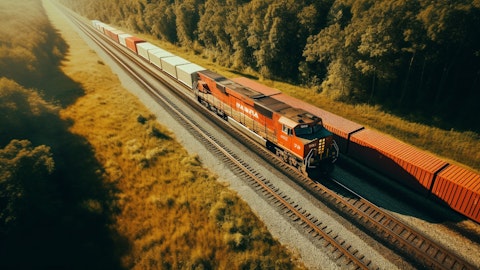Scott Group: Mark, any color on the OpEx, the OR, Q1, again, just I don’t know that I asked — you said the cost structure is too high. Does it come down or not? I guess I’m not sure what the answer is.
Mark George: So, I think as you go into Q1, you’re going to have some of the normal seasonality that has an impact on your OR. So, I think you need to expect that the first half, Q1 in particular, is probably going to step back, but then we feel much better as we lap a lot of the headwinds that we’ve been talking about from this first half, the intermodal storage charges, some of the fuel price and some of the other RPU challenges we’re having on coal price, I think as we get to that back half is where you’re going to really start to see much stronger incrementals and drop through.
Scott Group: Okay.
Operator: Thank you. Our next question comes from the line of Amit Mehrotra with Deutsche Bank. Please proceed with your question.
Amit Mehrotra: Thanks. Hi, everybody. Thanks for taking my question. I guess, Alan, if we look at the three-year plan, I think if you ask every railroad in North America, they tell you that they also would expect to improve margins by 100 basis points to 150 basis points a year from where we are today. So, I guess the negative implication of that outlook is that you’re not actually narrowing the gap, you’re just improving your position from where you are, but the gap actually stays intact. So, I’d be curious to get your perspective on that. And I think the cost structure is high, which is you’re addressing that by taking these difficult actions with non-salaried workers. And I know that’s a really difficult decision. But it seems also like when I look at the cost structure, it seems like the answer to something going wrong is throwing as many resources at that problem as possible.
If I look at materials expense or rents expense, and if I talk to any kind of operating intensive railroad, their answer is, you never really drown a problem with resources. That’s the opposite of what you should do. So, I’m trying to understand the removal of the non-union or the rationalization of the non-union employees is one step in that direction. But are we having a rethink about how we actually operate the railroad day-in and day-out and how we respond to issues? Because it seems like that’s kind of the root cause of the problem in terms of where the gap is today. Sorry for the long-winded question, but just want to get your perspective on that.
Alan Shaw: What was the first part of your question, Amit?
Amit Mehrotra: Well, just in terms of the — yeah, sure, Alan, the three-year outlook, 100 basis points to 150 basis points, every rail on the continent will think that. So, you’re not actually narrowing the gap. So that was the question.
Alan Shaw: Well, that’s our commitment. Our commitment is industry-competitive margins and top-tier revenue and earnings growth. And we said we were going to do that through an economic cycle. We said we would have difficulty within industry-competitive margins during a trough and the freight market. And candidly, we didn’t expect some of the incidents that occurred in 2023, the network disruptions, the Eastern Ohio incident, and a continuation of a very difficult truck market. We invested throughout 2023 for the long term, and in the long-term best interests of Norfolk Southern and our shareholders. And we improved service. We improved safety. Volumes grew in the fourth quarter. Now, we can really narrow our focus, right? We can narrow our focus into productivity, and that’s exactly what we’re doing.
And we’re going to drive that by operating to the plan, a high degree of compliance to the plan, that will shed resources, that’s going to shed a lot of the service recovery resources that you just referenced. As we get on plan, we’ll continue to iterate the plan and look for additional ways to drive out complexity, drive out costs and improve balance.
Mark George: And just adding to what Alan said, as we think back to the fourth quarter, it was all about driving intermodal service, recognizing that the service sensitivity of that was going to directly drive growth to this railroad, which we did see. The shift in the layering on now is towards driving that discipline and rigor inside of our merchandise network. We recognize that is where our single biggest opportunity is. Total T&E is as a result of that, essentially troughed in October. And we expect that we’re going to see greater productivity as we continue to dial-in our merchandise network. That’s going to be a reduced number of recrews and all the associated costs, taxis, hotels, deadheading, overtime, car hire, equipment expense.
We’re going to see improved capacity in our merchandise network as cars per carload improves. So that’s the flywheel impact that we’re talking about. So, to your question about what is fundamentally changing moving forward, it’s from where we are now moving forward, a direct focus on merchandise, recognizing that’s our next single biggest lever for productivity.
Alan Shaw: That’s where two-thirds of our operating costs are.
Operator: Thank you. Our next question comes from the line of Jon Chappell with Evercore ISI. Please proceed with your question.
Jon Chappell: Thank you. I hate to keep on the guidance a bit, but I’m going to move up to the revenue line here. I’m just trying to understand the roughly 3%. I get that there’s macro headwinds. I understand the first half may be difficult. But by the same token, you have incredibly easy volume comps, given all the disruption from February until August. And Ed talked about the continuation of the pricing above inflation. So, one would probably expect the volumes to be a little bit better than 3%, just given the comparisons. So, are we saying that all in yield may be down this year? Or is there just like a healthy element of conservatism that you’re putting into the macroeconomy in the first half of the year that may be tamping that number down?




